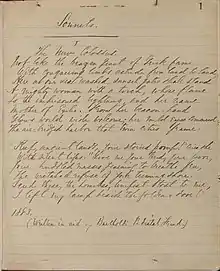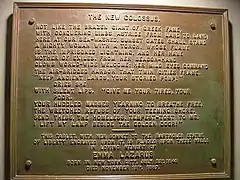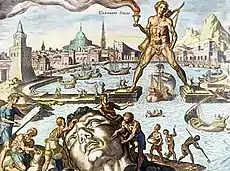| The New Colossus | |
|---|---|
 Emma Lazarus's manuscript for "The New Colossus" | |
| Created | 1883 |
| Location | Statue of Liberty, Liberty Island, New York City[1] |
| Author(s) | Emma Lazarus |
| Purpose | To raise money for construction of the statue's pedestal |
| Full Text | |
"The New Colossus" is a sonnet by American poet Emma Lazarus (1849–1887). She wrote the poem in 1883 to raise money for the construction of a pedestal for the Statue of Liberty (Liberty Enlightening the World).[2] In 1903, the poem was cast onto a bronze plaque and mounted inside the pedestal's lower level.
History of the poem

This poem was written as a donation to an auction of art and literary works[3] conducted by the "Art Loan Fund Exhibition in Aid of the Bartholdi Pedestal Fund for the Statue of Liberty" to raise money for the pedestal's construction.[4] Lazarus's contribution was solicited by fundraiser William Maxwell Evarts. Initially, she refused but writer Constance Cary Harrison convinced her that the statue would be of great significance to immigrants sailing into the harbor.[5] Lazarus was involved in aiding Jewish refugees to New York who had fled antisemitic pogroms in eastern Europe, and she saw a way to express her empathy for these refugees in terms of the statue.[6]
"The New Colossus" was the first entry read at the exhibit's opening on November 2, 1883. It remained associated with the exhibit through a published catalog until the exhibit closed after the pedestal was fully funded in August 1885,[7][8] but was forgotten and played no role at the opening of the statue in 1886. It was, however, published in Joseph Pulitzer's New York World as well as The New York Times during this time period.[9] In 1901, Lazarus's friend Georgina Schuyler began an effort to memorialize Lazarus and her poem, which succeeded in 1903 when a plaque bearing the text of the poem was put on the inner wall of the pedestal of the Statue of Liberty.[4]
On the plaque hanging inside the Statue of Liberty, the line "Keep ancient lands, your storied pomp!" is missing a comma. In Lazarus's manuscript, that line reads, "Keep, ancient lands, your storied pomp!"[10] The plaque also describes itself as an engraving; it is actually a casting.
The original manuscript is held by the American Jewish Historical Society.[11]
Text of the poem
Not like the brazen giant of Greek fame,
With conquering limbs astride from land to land;
Here at our sea-washed, sunset gates shall stand
A mighty woman with a torch, whose flame
Is the imprisoned lightning, and her name
Mother of Exiles. From her beacon-hand
Glows world-wide welcome; her mild eyes command
The air-bridged harbor that twin cities frame.
"Keep, ancient lands, your storied pomp!" cries she
With silent lips. "Give me your tired, your poor,
Your huddled masses yearning to breathe free,
The wretched refuse of your teeming shore.
Send these, the homeless, tempest-tost to me,
I lift my lamp beside the golden door!"[12]

Interpretation

"... the brazen giant of Greek fame,
With conquering limbs astride from land to land."
The poem is a Petrarchan sonnet.[13]
The title of the poem and the first two lines reference the Greek Colossus of Rhodes, one of the Seven Wonders of the Ancient World, a famously gigantic sculpture that stood beside or straddled the entrance to the harbor of the island of Rhodes in the 3rd century BC. In the poem, Lazarus contrasts that ancient symbol of grandeur and empire ("the brazen giant of Greek fame") with a "New" Colossus – the Statue of Liberty, a female embodiment of commanding "maternal strength" ("Mother of Exiles").[13][14]
The "sea-washed, sunset gates" are the mouths of the Hudson and East Rivers, to the west of Brooklyn. The "imprisoned lightning" refers to the electric light in the torch, then a novelty.
The "air-bridged harbor that twin cities frame" refers to New York Harbor between New York City and Brooklyn, which were separate cities at the time the poem was written, before being consolidated as boroughs of the City of Greater New York in 1898.[14]
The "huddled masses" refers to the large numbers of immigrants arriving in the United States in the 1880s, particularly through the port of New York.[15] Lazarus was an activist and advocate for Jewish refugees fleeing persecution in Imperial Russia.[16]
Influence

Immigration to the United States
Paul Auster wrote that "Bartholdi's gigantic effigy was originally intended as a monument to the principles of international republicanism, but 'The New Colossus' reinvented the statue's purpose, turning Liberty into a welcoming mother, a symbol of hope to the outcasts and downtrodden of the world."[17]
John T. Cunningham wrote that "The Statue of Liberty was not conceived and sculpted as a symbol of immigration, but it quickly became so as immigrant ships passed under the torch and the shining face, heading toward Ellis Island. However, it was [Lazarus's poem] that permanently stamped on Miss Liberty the role of unofficial greeter of incoming immigrants."[18]
The poem was quoted in John F. Kennedy's book A Nation of Immigrants (1958).[19] In 2019, during the Trump administration, Ken Cuccinelli, whom Trump appointed as acting director of U.S. Citizenship and Immigration Services, revised a line from the poem in support of the administration's "public charge rule" to reject applicants for visas or green cards on the basis of income and education. Cuccinelli added the caveat "Give me your tired and your poor who can stand on their own two feet, and who will not become a public charge"; later suggested that the "huddled masses" were European; and downplayed the poem as it was "not actually part of the original Statue of Liberty." Cuccinelli's remark prompted criticism.[20][21][22] The Trump administration rule was later blocked by a federal appeals court.[23]
In popular culture
Parts of the poem also appear in popular culture. The Broadway musical Miss Liberty, with music and lyrics by Irving Berlin, an immigrant himself, used the final stanza beginning "Give me your tired, your poor" as the basis for a song.[19][24] Joan Baez used the second half of the poem in her lyrics to The Ballad of Sacco and Vanzetti Part 1 which forms parts of Ennio Morricone's soundtrack to the 1971 Italian film Sacco & Vanzetti, based on the events surrounding the trial and judicial execution of the Italian-born American anarchists Nicola Sacco and Bartolomeo Vanzetti.[25]
The American Jewish Historical Society in New York City has a "New Colossus Project" of exhibitions, videos, and curriculum related to the poem. It also hosts the "New Colossus Translation Project" (produced by Alicia Ostriker, Mihaela Moscaliuc, and Tess O'Dwyer); it publishes translations of the poem into other languages by poets from around the world, including Emma Lazarus’ biographer Esther Schor's translation into Esperanto, Karen Alkalay-Gut's into Hebrew, Ming Di's into Chinese, Dunya Mikhail's into Arabic, and Giannina Braschi into Spanish.[26][27]
The poem is frequently recited or referenced in works of fiction, such as literature, film, and video games. Some examples include a version of the poem recited in Cixin Liu's The Dark Forest (first published in Chinese in 2008 and in English in 2015), the second volume of the science-fiction trilogy Remembrance of Earth's Past.[28] The poem was also read in the 1941 film Hold Back the Dawn as well as being recited by the heroine in Alfred Hitchcock's wartime film Saboteur.[19] It is recited by B.J. Blazkowicz at the end of the 2014 video game Wolfenstein: The New Order. The poem is also the subtitle of the game's sequel: Wolfenstein II: The New Colossus. In Dimension 20: The Unsleeping City, a character based on Emma Lazarus and bearing the same name appears in several episodes.
References
- ↑ "Statue of Liberty National Monument". US: National Park Service. December 31, 2007. Retrieved July 24, 2008.
- ↑ Lazarus, Emma, The New Colossus, Liberty State Park
- ↑ Sutherland, Cara A (2003), The Statue of Liberty: The Museum of the City of New York, Barnes & Noble, p. 77, ISBN 0-7607-3890-4,
auction of art and literary work
; Mark Twain also contributed. - 1 2 Young, Bette Roth (1997), Emma Lazarus in Her World: Life and Letters, The Jewish Publication Society, p. 3, ISBN 0-8276-0618-4,
…fell into obscurity. At the unveiling of the statue […] both Emma and her sonnet were absent […] Georgina Schuyler set in motion a successful attempt to memorialize her friend by placing the poem, inscribed on a bronze tablet, inside the pedestal…
. - ↑ Felder, Deborah G; Rosen, Diana L (2003), Fifty Jewish Women Who Changed the World, Citadel, p. 45, ISBN 0-8065-2443-X,
…William Maxwell Evert [sic; presumably a misspelling of "William Maxwell Evarts] asked […] Lazarus[…] to compose original works […] who […] refused […] until […] Constance Cary Harrison[…] suggested that she consider what the statue would mean to the thousand of immigrants who would see it as they sailed into New York…
. - ↑ Khan, Yasmin Sabina (2010). Enlightening the World: The Creation of the Statue of Liberty. Ithaca, New York: Cornell University Press. pp. 165–166. ISBN 978-0-8014-4851-5.
- ↑ "Image-Art Loan Fund Exhibition in Aid of the Bartholdi Pedestal Fund for the Statue of Liberty Catalogue".
- ↑ "The Statue of Liberty – Engineering, Construction, and Crossing the Atlantic". February 28, 2020.
- ↑ "National Park Service-Statue of Liberty-Emma Lazarus".
- ↑ Shapiro, Gary (December 8, 2006). "Misprint is spied in Lazarus poem at Liberty island". The New York Sun. Archived from the original on February 7, 2023. Retrieved June 8, 2007.
- ↑ Roberts, Sam (2011), "How a Sonnet Made a Statue the 'Mother of Exiles'", New York Times, retrieved November 21, 2013
- ↑ Lehman, David, ed. (2006). The Oxford Book of American Poetry. Oxford University Press. p. 184. OCLC 62697134.
- 1 2 Hunter, Walt (January 16, 2018). "The Story Behind the Poem on the Statue of Liberty". The Atlantic. Retrieved August 14, 2019.
- 1 2 Allen, Austin (November 22, 2017). "Emma Lazarus: "The New Colossus"". Poetry Foundation. Retrieved August 13, 2019.
- ↑ "Immigration and Americanization, 1880–1930". Digital Public Library of America.
- ↑ Mettler, Katie (February 1, 2017). "'Give me your tired, your poor': The story of poet and refugee advocate Emma Lazarus". The Washington Post.
- ↑ Auster, Paul (2005), "NYC = USA", Collected Prose: Autobiographical Writings, True Stories, Critical Essays, Prefaces, and Collaborations with Artists, Picador, p. 508, ISBN 0-312-42468-X.
- ↑ Cunningham, John T (2003), Ellis Island: Immigration's Shining Center, Arcadia Publishing, pp. 46–48, ISBN 0-7385-2428-X.
- 1 2 3 McGill, Meredith L. (2008). The Traffic in Poems: Nineteenth-century Poetry and Transatlantic Exchange. Rutgers University Press. p. 118. ISBN 9780813542300.
- ↑ "Immigration official Ken Cuccinelli: Statue of Liberty poem refers to immigrants from Europe". USA Today. August 13, 2019.
- ↑ "Trump official revises Statue of Liberty poem to defend migrant rule change". BBC News. August 14, 2019.
- ↑ Jacey Fortin (August 14, 2019). "'Huddled Masses' in Statue of Liberty Poem Are European, Trump Official Says". New York Times.
- ↑ Jacey Fortin (August 4, 2020). "Appeals Court Blocks Immigrant Wealth Test in the Northeast". New York Times.
After announcing the policy, Kenneth T. Cuccinelli, the department's acting deputy secretary and a defendant in the case, promoted the rule by revising the iconic sonnet on the Statue of Liberty by saying the United States would welcome those "who can stand on their own two feet.' He added that the verses, written by Emma Lazarus, referred to 'people coming from Europe where they had class-based societies.'
- ↑ Esther Schor, Emma Lazarus, Knopf Doubleday Publishing Group – 2008, page 255
- ↑ Stipes., Watts, Emily (1977). The poetry of American women from 1632 to 1945. Austin: University of Texas Press. ISBN 0292764359. OCLC 2463497.
{{cite book}}: CS1 maint: multiple names: authors list (link) - ↑ Lehman, David. ""The New Colossus" Translation Project [by Mihaela Moscaliuc]". The Best American Poetry. Retrieved October 8, 2020.
The project features Esther Schor into Esperanto, Israeli-based poet Karen Alkalay-Gut rendering it into Hebrew, Rose Waldman into Yiddish, Ming Di into Chinese, Dunya Mikhail into Arabic, and Emma Asonye into Igbo.. and Puerto Rican poet Giannina Braschi riffs metaphorically.
- ↑ "AJHS | "Give Me Your Tired.." : Poem, 135 years old, Makes Waves". American Jewish Historical Society. Archived from the original on June 15, 2022. Retrieved October 8, 2020.
- ↑ Page 275 of the Tor Paperback edition, 2015.
External links
 The New Colossus public domain audiobook at LibriVox (multiple versions)
The New Colossus public domain audiobook at LibriVox (multiple versions)- "A Century of Immigration, 1820–1924". Library of Congress. September 9, 2004.
Courtesy of the American Jewish Historical Society, New York and Newton Centre, Massachusetts
. Emma Lazarus' handwritten sonnet "The New Colossus" The poem itself, having been published in 1883 or at the very latest 1903 is in the public domain. - ———. Schor, Esther (ed.). The New Colossus (interactive ed.). Nextbook Press.
- Manuscript notebook from the Emma Lazarus collection at the American Jewish Historical Society. Includes an undated manuscript version of "The New Colossus".
- Cavitch, Max (2008). "Emma Lazarus and the Golem of Liberty". In The Traffic in Poems: Nineteenth-Century Poetry and Transatlantic Exchange. Meredith L. McGill (ed.). New Brunswick: Rutgers University Press. app. 97–122.
- Marom, Daniel (2000). "Who Is the 'Mother of Exiles'? An Inquiry into Jewish Aspects of Emma Lazarus's 'The New Colossus'". Prooftexts. 20 (3): 231–61. doi:10.1353/ptx.2000.0020. S2CID 161389678.
- The New Colossus - Emma Lazarus as read on YouTube
